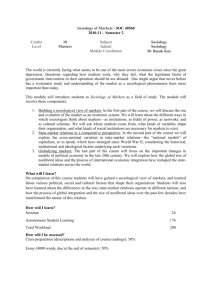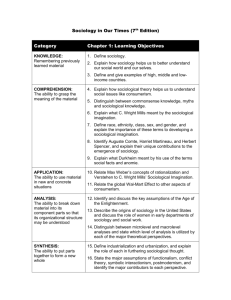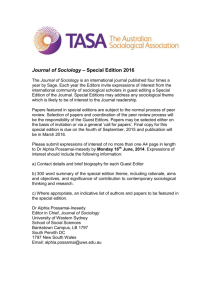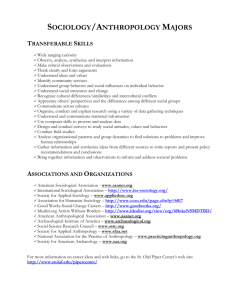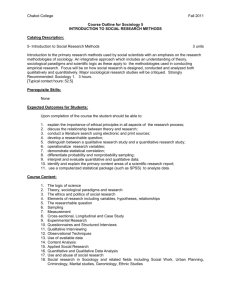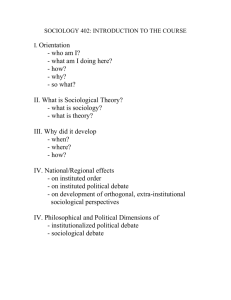05 FALL Comp Reading (Life Course and Health) I. Life Course P
advertisement
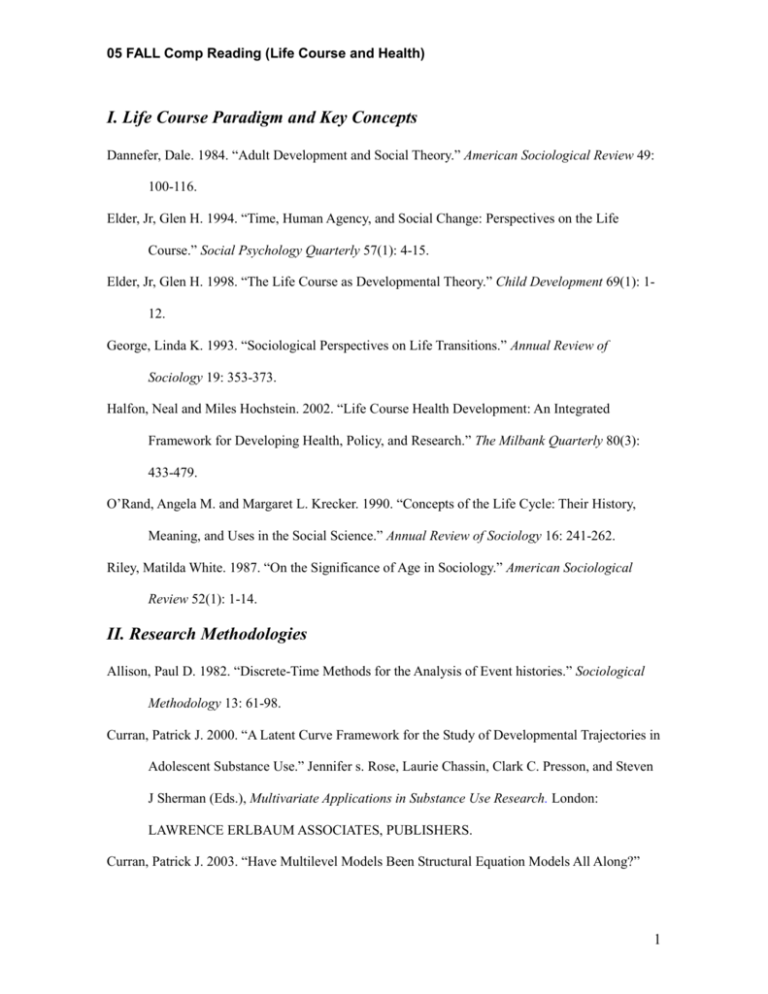
05 FALL Comp Reading (Life Course and Health) I. Life Course Paradigm and Key Concepts Dannefer, Dale. 1984. “Adult Development and Social Theory.” American Sociological Review 49: 100-116. Elder, Jr, Glen H. 1994. “Time, Human Agency, and Social Change: Perspectives on the Life Course.” Social Psychology Quarterly 57(1): 4-15. Elder, Jr, Glen H. 1998. “The Life Course as Developmental Theory.” Child Development 69(1): 112. George, Linda K. 1993. “Sociological Perspectives on Life Transitions.” Annual Review of Sociology 19: 353-373. Halfon, Neal and Miles Hochstein. 2002. “Life Course Health Development: An Integrated Framework for Developing Health, Policy, and Research.” The Milbank Quarterly 80(3): 433-479. O’Rand, Angela M. and Margaret L. Krecker. 1990. “Concepts of the Life Cycle: Their History, Meaning, and Uses in the Social Science.” Annual Review of Sociology 16: 241-262. Riley, Matilda White. 1987. “On the Significance of Age in Sociology.” American Sociological Review 52(1): 1-14. II. Research Methodologies Allison, Paul D. 1982. “Discrete-Time Methods for the Analysis of Event histories.” Sociological Methodology 13: 61-98. Curran, Patrick J. 2000. “A Latent Curve Framework for the Study of Developmental Trajectories in Adolescent Substance Use.” Jennifer s. Rose, Laurie Chassin, Clark C. Presson, and Steven J Sherman (Eds.), Multivariate Applications in Substance Use Research. London: LAWRENCE ERLBAUM ASSOCIATES, PUBLISHERS. Curran, Patrick J. 2003. “Have Multilevel Models Been Structural Equation Models All Along?” 1 05 FALL Comp Reading (Life Course and Health) Multivariate Behavioral Research 38(4): 529-569. Wickrama, K. A. S., Frederick O. Lorenz, Rand D. Conger, Lisa Matthews, and Glen h. Elder Jr. 1997. “Linking Occupational Condition to Physical Health through Marital, Social, and intrapersonal Process.” Journal of Health and Social Behavior 38(4): 363-375. III. Social Context, SES and Life Course Crosnoe, Robert. 2000. “Friendships in Childhood and Adolescence: The Life Course and New Direction.” Social Psychological Quarterly 63(4): 377-391. Hagan, John, Ross McMillan, and Blair Wheaton. 1996. “New Kid in Town: Social Capital and the Life Course Effects of Family Migration on Children.” American Sociological Review 61(3): 368-385. McLeod, Jane D. and Michael J. Shanahan. 1996. “Trajectories of Poverty and Children’s Mental Health.” Journal of Health and Social Behavior 37(3): 207-220. Mirowsky, John and Catherine E. Ross. 1999. “Economic Hardship Across the Life Course.” American Sociological Review 64: 548-569. Pavalko, Eliza K, Glen H. Elder Jr., and Elizabeth C. Clipp. 1993. “Worklives and Longevity: Insights from a Life Course Perspective.” Journal of Health and Social Behavior 34(4): 363380. Rosenfeld, Rachel. 2002. “Scholarship and Gender.” Social Forces 81(1): 1-24. Sampson, Robert J. and John H. Laub. 1996. “Socioeconomic Achievement in the Life Course Disadvantaged Men: Military Service as a Turning Point, Circa 1940-1965.” American Sociological Review 61(3): 347-367. Warren, John Robert, Jennifer T. Sheridan, and Robert M. Hauser. 2002. “Occupational Stratification across the Life Course: Evidence from the Wisconsin Longitudinal Study.” American Sociological Review 67(3): 432-455. 2 05 FALL Comp Reading (Life Course and Health) IV. Childhood and Adolescence Browning, Christopher R. and Edward O. Laumann. 1997. “Sexual Contact between Children and Adults: A Life Course Perspective.” American Sociological Review 62(4): 540-560. Clausen, John A. 1991. “Adolescent Competence and the Shaping of the Life Course.” American Journal of Sociology 96: 805-842. Coleman, James S. 1988. “Social Capital and the Creation of Human Capital.” American Journal of Sociology 94: S95-120. Dornbusch, Sanford M. 1989. “The Sociology of Adolescence.” Annual Review of Sociology 15: 233-259. Graefe, Deborah R. and Daniel T. Lichter. 1999. “Life Course Transition of American Children: Parental Cohabitation, Marriage, and Single Motherhood.” Demography 36(2): 205-217. Hayward, Mark D. and Bridget K. Gorman. 2004. “The Long Arm of Childhood: The Influence of Early Life Social Conditions on Men’s Mortality.” Demography 41(1): 87-107 McLoyd, Vonnie. 1990. “The Impact of Economic Hardship on Black Families and Children: Psychological Distress, Parenting, and Socioemotional Development.” Child Development 61(2): 311-346. V. Adulthood Gove, Walter R., Suzane T. Ortega, and Carolyn B. Style. 1989. “The Maturational and Role Perspective on Aging and Self through the Adult Years: An Empirical Evaluation.” American Journal of Sociology 94(5): 1117-1145. Hogan, Dennis P. and Nan Marie Astone. 1986. “The Transition to Adulthood.” Annual Review of Sociology 12: 109-130. Levinson, Daniel. 1986. “A Conception of Adult Development.” American Psychologist 41: 3-13. Lewis, Susan K., Catherine R. Ross, and John Mirowsky. 1999. “Establishing a Sense of Control in 3 05 FALL Comp Reading (Life Course and Health) the Transition to Adulthood.” Social Forces 77(4): 1573-1599. Rindfuss, Ronald R., C. Gary Swicegood, and Rachel A. Rosenfeld. 1987. “Disorder in the Life Course: How Common and Does it Matter?” American Sociological Review 52(6): 785-801. VI. Aging Crimmins, Eileen M. 2004. “Trends in the Health of the Elderly.” Annual Review of Public Health 25: 79-98. Crimmins, Eileen M., Mark D. Hayward, and Y. Saito. 1994. “Changing Mortality and Morbidity Rates and the Health Status and Life Expectancy of the Older Population.” Demography 31(1): 159-175. Crosnoe, Robert and Glen H. Elder Jr. 2002. “Successful Adaptation in the Later Years: A Life Course Approach to Aging.” Social Psychological Quarterly 65(4): 309-328. Drentea, Patricia. 2000. “Retirement and Mental Health.” Journal of Aging and Health 14(2): 167194. Duncan, Greg J. and Ken R. Smith. 1989. “The Rising Affluence of the Elderly: How Far, How Fair, and How Frail?” Annual Review of Sociology 15: 261-289. Gove, Walter R., Suzanne T. Ortega, Carolyn Briggs Style. 1989. “The Maturation and Perspectives on Aging and Self through the Adult Years: An Empirical Evaluation.” American Journal of Sociology 94(5): 1117-1145. Hareven, Tamara K. 1994. “Aging and Generational Relations: A Historical and Life Course Perspective.” Annual Review of Sociology 20: 437-461. Lauderdale, Diane S. 2001. “education and Survival: Birth Cohort, Period, and Age Effects.” Demography 38(4): 551-561. Logan, Jogan R. 1992. “As old as You Feel: Age Identity and Middle and Late Life.” Social Forces 71: 451-467. 4 05 FALL Comp Reading (Life Course and Health) Moen, Phyllis, Donna Dempster-McCain, and Robin M. Williams Jr. 1992. “Successful Aging: A Life-Course Perspective on Women’s Multiple Roles and Health.” American Journal of Sociology 97(6): 1616-1638. Settersten, Richard A. Jr. and Karl Ulrich Mayer. 1997. “The Measurement of Age, Age Structuring, and the Life Course.” Annual Review of Sociology 23: 233-261. VII. Family and Family Relationships Chase-Landale, P. Lindsay, Andrew J. Cherlin, and Kathleen E. Kiernan. 1995 “The Long-Term Effects of Parental Divorce on the Mental Health of Young Adults: A Developmental.” Child Development 66: 1614-1634. Cherlin, Andrew J., P. Lindsay Chase-Lansdale, and Christine McRae. 1998. “Effects of Parental Divorce on Mental Health through the Life Course.” American Sociological Review 63(2): 239-249. Cook, Judith A., Bertram J. Cohler, Susan Pickett, and Jeff A. Beeler. 1997. “Life Course and Severe Mental Illness: Implications for Cargiving within the Family of Later Life.” Family Relations 46(4): 427-436. Cooksey, Elizabeth C., Elizabeth G. Menaghan, and Susan M. Jekielek. 1997. “Life Course Effects of Work and Family Circumstances on Children.” Social Forces 76(2): 637-665. Orbuch, Terri L., James S. House, Richard P. Mero, and Pamela S. Webster. 1996. “Marital Quality over Life Course.” Social Psychology Quarterly 59(2): 162-171. Waite, Linda J. 1995. “Does Marriage Matter?” Demography 32(4): 4831-507. Williams, Kristi and Debra Umberson. 2004. “Marital Status, Marital Transitions, and Health: A Gendered Life Course Perspective.” Journal of Health and Social Behavior 45(1): 81-98. IIX. Health Status and Trajectories Beckett, M. 2000. “Converging Health Inequalities in Later Life - An Artifact of Mortality 5 05 FALL Comp Reading (Life Course and Health) Selection?” Journal of Health and Social Behavior 41(1): 106-119. Elder, Jr, Glen H. Elder and Jeffrey K. Liker. 1982. “Hard Times in Women’s Lives: Historical Influences across Forty Years.” American Journal of Sociology 88(2): 241-269. Ferraro, Kenneth F., Melissa m. farmer, and John A. Wybraniec. 1997. “Health Trajectories: Long Term Dynamics Among Black and White Adults.” Journal of Health and Social Behavior 38(1): 38-54. Lynch, Scott M. 2003. “Cohort and Life-Course Patters in the Relationship Between Education and Health: A Hierarchical Approach.” Demography 40(2): 309-331. Maddox, George L. and Daniel O. Clark. 1992. “Trajectories of Functional Impairment in Later Life.” Journal of Health and Social Behavior 33(2): 114-125. Miech, Richard Allen and Michael J. Shanahan. 2000. “Socioeconomic Status and Depression over the Life Course.” Journal of Health and Social Behavior 41(2): 162-176. Mirowsky, John. 1995. “Age and the Sense of Control.” Social Psychology Quarterly 58(1): 31-43. Mirowsky, John and Catherine E. Ross. 1992. “Age and Depression.” Journal of Health and Social Behavior 33(3): 187-205. Mirowsky, John and Catherine E. Ross. 2001. “Age and the Effect of Economic Hardship on Depression.” Journal of Health and Social Behavior 42(2): 132-150. Moen, Phyllis, Julie Robinson, and Donna Dempster-McCain. 1995. “Caregiving and Women’s Well-Being.” Journal of Health and Social Behavior 36(3): 259-273. Pope, Sandra K., Valorie M. Shue, and Cornelia Beck. 2003. “Will a Healthy Lifestyle Help Prevent Alzheimer’s Disease?” Annual Review of Public Health 24: 111-132. Rindfuss, Ronald R., C. Gray Swicegood, and Rachel A. Rosenfeld. 1987. “Disorder in the Life Course: How Common and Does It Matter?” American Sociological Review 52(6): 785-801. Schieman, Scott, Karen Van Gundy, and John Taylor. 2001. “Status, Role, and Resources Explanations for Age Patterns in Psychological Distress.” Journal of Health and Social 6 05 FALL Comp Reading (Life Course and Health) Behavior 42(1): 80-96. Seeman, Melvin and Susan Lewis. 1995. “Powerlessness, Health and Mortality: A Longitudinal Study of Older Men and Mature Women.” Social Science and Medicine 41(4): 517-525. Wheaton, Blair. 1990. “Life Transitions, Role Histories, and Mental Health.” American Sociological Review 55(2): 209-223. Williams, Kristi and Debra Umberson. 2004. “Marital Status, Marital Transitions, and Health: A Gendered Life Course Perspective.” Journal of Health and Social Behavior 45(1): 81-98. 7


